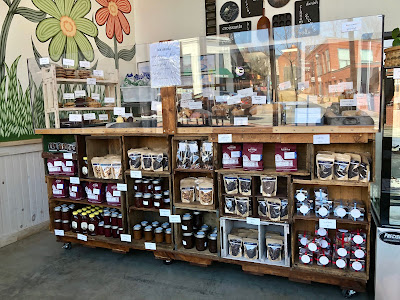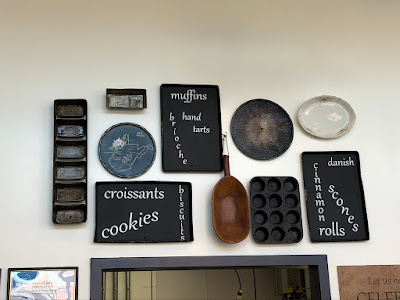At the
Seafood Expo North America (SENA), I attended a conference session,
Seadood Trends & Preferences in Foodservice Moving Forward. Led by
Mark DiDomenico, of
Datassential, a company which tracks food trends, the session examined seafood trends in the U.S. food service industry, including restaurants and supermarkets with prepared foods. The session provided some fascinating insights, including ways where the food service industry could sell more seafood.
The session began with some general insights into the food service industry during the pandemic. In 2021, foodservice sales were down 13% from pre-pandemic levels, and it was predicted that such sales wouldn't rise above pre-pandemic levels until at least 2023. As inflation has been rising, consumers have indicated that the top item they have cut from their budgets has been dining out. The next items they cut included clothing, live entertainment and travel.
During the pandemic, over half of foodservice operators also had to raise menu prices, due to a number of factors including: higher food & ingredient costs, higher labor costs, general inflation, supply chain shortages causing them to use higher cost replacements, and more. In addition, about 60% of their menus shrunk in size, by about 10%. This also contributed to less consumers patronizing restaurants.
The session then turned to seafood issues, noting that about 34% of consumers were trying to consume more seafood, as opposed to about 18% of consumers who wanted to consume more chicken and 11% more red meat. That's a positive sign for seafood suppliers that a significant number of consumers want to eat more seafood. In addition, most consumers are concerned about seafood sustainability. A survey noted that 48% of consumers were "very concerned" about sustainability and 42% were "somewhat concerned."
Even during the pandemic, the seafood industry had some gains on menu penetration (how many food service menus an item was listed on). For example, in 2021, stir fried shrimp had a menu penetration of 1.1%, with a one year change of about 24%. Tuna nigiri had menu penetration of 1% with a one year change of about 14%. Other seafood gains included Alaskan cod, 1.2% penetration and 12% growth, and imitation crab, 1.9% penetration and 11.5% growth. Battered fish had the highest menu penetration at 3%.
It's important to note that only about 57% of menus have seafood on them. There is definitely room for growth here, that more restaurants could add seafood to their menus, and cater to the growing desire of consumers to eat more fish. It's also interesting that about 38% of consumers like to try new foods, but that is tempered with the information that 48% of those consumers want "safe experimentation." These consumers want to try new items, but which come in a more familiar form. They want to try new things in small steps, enhancing dishes which they already know and love. That's important for restaurants to understand, so they can find ways to introduce new items within what is already familiar.
The pandemic has led to far more consumers preparing seafood at home, reversing a trend which had long been the case. As I've mentioned previously, consumers used to eat far more seafood out at restaurants than at home. Part of the reason for this was that many Americans worried about how to properly cook seafood at home. During the pandemic, this changed, especially as so many restaurants were closed for a lengthy period of time. About 42% of consumers claimed that they now bought seafood for consumption at home, and only 22% had dined on seafood at a restaurant.
This is likely to change now that many restaurants have reopened, and more consumers are dining out. Hopefully, consumers will continue to prepare seafood at home too, simply eating more fish overall at both home and out at restaurants. One way for restaurants to be more inventive with seafood dishes is with using different sauces and spices in the preparation. This can help with safe experimentation, as consumers will likely see those new sauces and spices as familiar enough to give a try.
In 2021, the Top Ten Sauces/Spices for Seafood included: 1) Sauce, 65% menu penetration; 2) Garlic, 39%; 3) Lemon 30%; 4) Butter 26%; 5) Tartar 16%; 6) Ginger 13%; 7) Curry 12%; 8) Herb 11%; 9) Garlic Sauce 10%; and 10) Red Sauce 10%. These are the items that are most familiar to consumers, and used most often at restaurants. Paying attention to safe experimentation, restaurants could use these familiar sauces/spices with less familiar types of seafood, to give consumers something new, but familiar, to try.
There are other sauces/spices which have seen great growth during the last four years, but which have not yet achieved significant menu penetration. The Top Ten Fast Growing Sauces/Spices for Seafood
include: 1) Chimichurri 1.1% menu penetration & a 4 year growth of 61%; 2) Marinade 1.3% & 41% growth; 3) Mongolian 1% & 38% growth; 4) Chipotle Sauce 1.2% & 37% growth; 5) Sweet Chile Sauce 1.2 & 31% growth; 6) Eel Sauce 3.5% & 28% growth; 7) Spicy Mayo 3.6% & 24% growth; 8) Lemon Caper 1.8% & 21% growth; 9) Honey 6.6% & 18% growth; and 10) Brown Sauce 3.1 & 17% growth. These are the sauces and spices that restaurants should consider adding to their seafood dishes, capitalizing on their growing popularity.
If a restaurant wants to be even more cutting edge, they could consider some of the hottest sauces/spices, those which are extremely popular on other dishes but which haven't yet become as popular on seafood dishes. The Top Ten includes: 1) Nashville Hot, 2.5% menu penetration & 1 year change of 33%; 2) Hot Mustard 1.3% & 29% change; 3) Spicy Honey 3.2% & 26% change; 4) Honey Lemon 1.1% & 21% change; 5) Furikake 1.4% & 20% change; 6) White Truffle Oil 1.5% & 18% change; 7) Gochujang 2.3% & 14.4% change; 8) Sambal 1.6% & 13% change; 9) Peruvian 1.8% & 12% change; 10) Dried Chili 1% & 11% change.
The session also included some fascinating information on the top sauces/spices per geographical region, including the South, West, Midwest, and Northeast. In the Northeast, Italian sauces were very popular and the Top Ten Sauces/Spices included: Vodka Sauce, Black Truffle, Bleu Cheese Dressing, Bolognese, Vodka, Romesco, Clam Sauce, Red Clam Sauce, Carbonara, White Clam Sauce. Additional popular sauces included Meat Sauce, Mustard Sauce, Pink Sauce, Ragu, and Basil Pesto.
Restaurant owners, what is the most different type of sauces/spices that you have recently used on seafood dishes?

















































